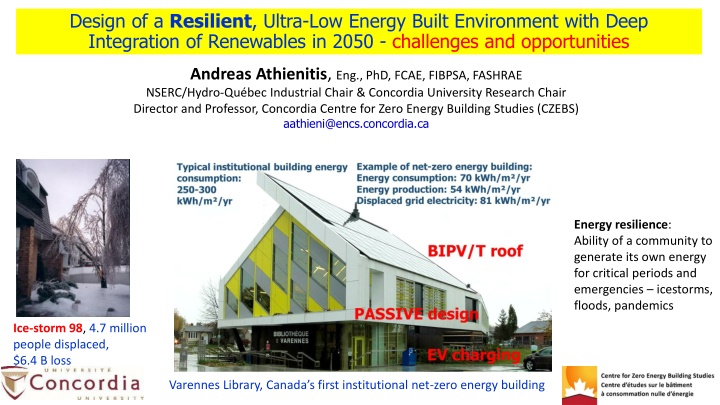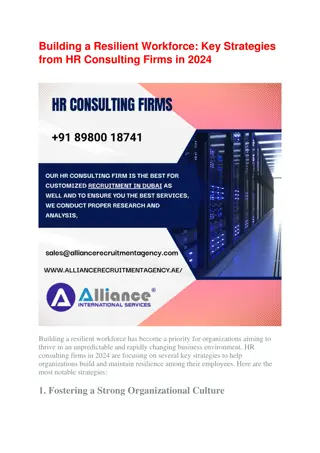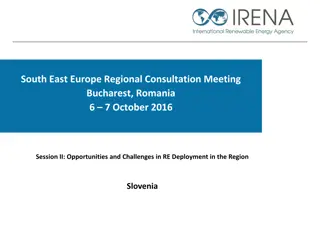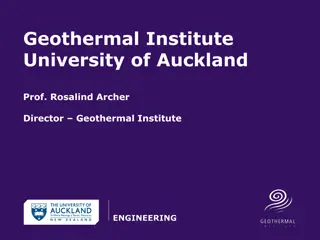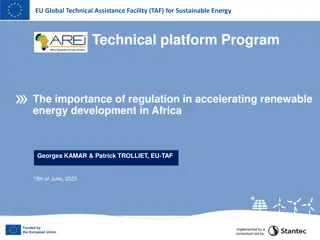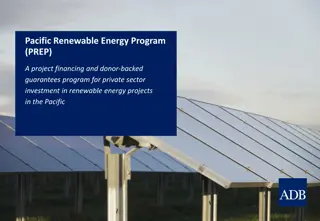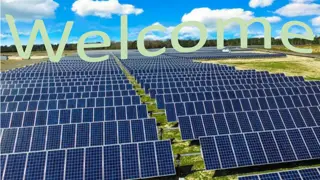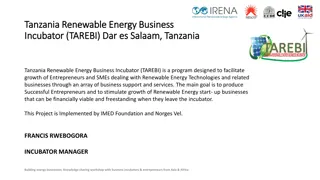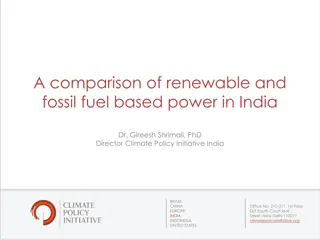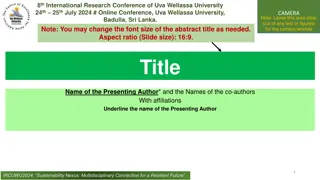Building Resilient & Sustainable Environments with Renewable Integration
Challenges and opportunities in achieving energy resilience, sustainability, and innovation in Canada's built environment by 2050. Focus on decarbonization, building design for emergencies, transversal innovation, and urban planning for a better future.
Uploaded on Oct 04, 2024 | 3 Views
Download Presentation

Please find below an Image/Link to download the presentation.
The content on the website is provided AS IS for your information and personal use only. It may not be sold, licensed, or shared on other websites without obtaining consent from the author.If you encounter any issues during the download, it is possible that the publisher has removed the file from their server.
You are allowed to download the files provided on this website for personal or commercial use, subject to the condition that they are used lawfully. All files are the property of their respective owners.
The content on the website is provided AS IS for your information and personal use only. It may not be sold, licensed, or shared on other websites without obtaining consent from the author.
E N D
Presentation Transcript
Design of a Resilient, Ultra-Low Energy Built Environment with Deep Integration of Renewables in 2050 - challenges and opportunities Andreas Athienitis, Eng., PhD, FCAE, FIBPSA, FASHRAE NSERC/Hydro-Qu bec Industrial Chair & Concordia University Research Chair Director and Professor, Concordia Centre for Zero Energy Building Studies (CZEBS) aathieni@encs.concordia.ca Energy resilience: Ability of a community to generate its own energy for critical periods and emergencies icestorms, floods, pandemics Ice-storm 98, 4.7 million people displaced, $6.4 B loss Varennes Library, Canada s first institutional net-zero energy building
How can Canada achieve Resilience + Sustainability + Innovation Major challenges Decarbonization of the built environment by 2050; we spend over 90% of our time indoors Design of buildings and communities for resilience and a high quality of life, suited to protecting people during emergencies, including pandemics (ventilation etc) Design of the built environment for flexibility and safety of all groups (including elderly, kids, disabled) Complexity: Need for Transversal Innovation, integration of novel renewable energy technologies, building technologies, mobility technologies, smart technologies and energy grids Major opportunities More than half of buildings will be new by 2050; rest will undergo deep retrofits Massive construction projects with emphasis on cross-cutting transversal integration and innovation across energy, construction, manufacturing and public health + wellbeing Planning for partial teleworking can aid in more flexible work schedules for families and reduction in transportation emissions Can public sectors take the lead with emphasis on high risk high reward transversal innovation? in close collaboration with universities and industries? Innovative urban planning approaches to zoning, density and technology adoption
Single-goal approaches vs transversal integrated approaches Most government programs for technology development/adoption tend to focus on single-sector easy-to-explain approaches (such as decarbonization by itself); industry and cities tend to adapt to this approach Increasingly we are dealing with complex strongly linked issues such as built environment design for decarbonization + resilience + wellbeing + health An integrated approach is followed in the Canadian Academy of Engineering Roadmap to Resilient, Ultra-Low Energy Built Environment with Deep Integration of Renewables in 2050 https://cae-acg.ca/projects/resilient-infrastructure-project/ Photovoltaic/thermal 2008, 2009 West5 community London Ont. EV, BIPV - current Drake Landing Solar Community Solar seasonal storage + gas 2016 & ongoing study JMSB Building, Concordia
References N. E. Klepeis et al. "The National Human Activity Pattern Survey (NHAPS): a resource for assessing exposure to environmental pollutants," Journal of Exposure Science & Environmental Epidemiology, vol. 11, no. 3, pp. 231-252, 2001. Environment and Climate Change Canada, "Canada's Mid-Century long-term low-greenhouse gas Development Strategy," Minister of Environment and Climate Change, Gatineau, 2016. E. L. Lecomte, A. W. Pang and J. W. Russell, "Ice Storm 98," Institute for Catastrophic Loss Reduction, 1998. A. K. Athienitis and W. O'Brien, Modeling, design, and optimization of net-zero energy buildings, Berlin: Ernst & Sohn, 2015. ASHRAE, "Position Document on Infectious Aerosols," American Society of Heating, Refrigerating and Air-Conditioning Engineers, Atlanta, Georgia, 2020. V. Dermardiros, A. K. Athienitis and S. Bucking, "Energy performance, comfort, and lessons learned from an institutional building designed for net zero energy," ASHRAE Transactions, vol. 125, pp. 682-695, 2019. Canadian Consulting Engineer, Magazine for professional engineers in construction, [Online]. Available: https://www.canadianconsultingengineer.com/features/varennes-net-zero-library-award-excellence/ C. A. Kennedy and A. Pape-Salmon, "Jurisdictional Responsibility for Improving the Resilience of Buildings to Climate-related Power Outages," in Canadian Academy of Engineering 2020 Symposium - Roadmap to Resilient Ultra-Low Energy Built Environment with Deep Integration of Renewables in 2050, Montreal, 2020. "Paris Mayor: It's Time for a '15-Minute City'," Bloomberg, [Online]. Available: https://www.bloomberg.com/news/articles/2020- 02-18/paris-mayor-pledges-a-greener-15-minute-city W. T. O'Brien, C. A. Kennedy, A. K. Athienitis and T. J. Kesik, "The relationship between net energy use and the urban density of solar buildings," Environment and Planning B: Planning and Design, vol. 37, no. 6, pp. 1002-1021, 2010. "West5," 2017. [Online]. Available: https://west5.ca/news/2017-smart-energy-communities-award.
